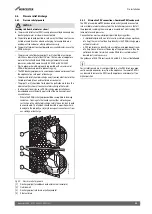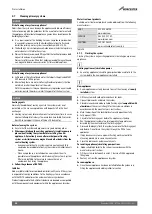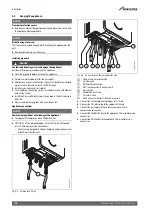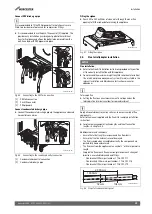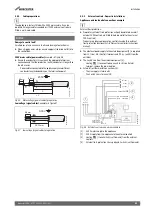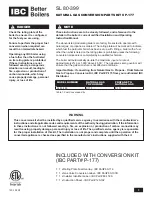
Pre-Installation
Greenstar 2000 – 6 721 820 552 (2021/02)
28
4.5
Condensate discharge
Full details on condensate discharge.
▶ Follow the latest version of
BS6798
and HHIC guidance.
For correct installation and trouble free operation of the appliance the
following advice should be followed:
1.
It is a requirement that the condensate drain is installed
internally.
2.
If external disposal is the only means of condensate discharge,
then the CondenseSure siphon or a condensate pump must be
fitted.
3. All condensate pipe work must ‘fall’ from the appliance by a minimum
of 3° (52mm per metre) to ensure adequate condensate flow.
4. The pipe work route must allow air to be supplied back to the
appliance for correct operation.
5. Connection to a rainwater down pipe must include an air break.
Also:
• Assessment of the risk of the condensate pipe freezing must be
carried out and appropriate precautions taken where necessary.
This must take into account the specific site conditions.
• The condensate pipe work connected to the condensate drain outlet
on the appliance should have a minimum internal diameter (ID) of
19mm.
• Keep external pipe work as short as possible.
Further precautions against freezing must be taken if external pipe
runs exceed 3m.
• External pipe work should have a minimum internal diameter (ID) of
30mm.
• Minimise the number of bends and connectors.
• Remove burrs and cutting debris after the cutting pipe.
• Remove surplus solvent from the interior of the pipe.
• The condensate pipe work shall be run in standard drainpipe
material, e.g. polyvinyl chloride (PVC), unplasticised poly vinyl
chloride (PVC-U), acrylonitrilebutadiene.styrene (ABS),
polypropylene (PP) or chlorinated poly vinyl chloride (PVC.C).
4.5.1
Condensate pipework
NOTICE
General consideration
▶ Where a new or replacement appliance is being installed, access to
an internal “gravity discharge” point should be one of the factors
considered in determining appliance location.
▶ Condensate pipe connection at the appliance:
The condensate pipe must have a nominally outside diameter of
22mm plastic pipe.
▶ Ensure there are no blockages in the pipe run.
▶ Ensure that the discharge method for the installation can effectively
handle the condensate waste from the appliance.
NOTICE
Unheated internal areas.
The condensate discharge may freeze in areas during prolonged cold
temperatures.
▶ Internal pipe runs in unheated areas such as lofts, basements and
garages should be treated as external runs and consideration should
be given to using a CondenseSure siphon.
4.5.2
Condensate production
When the appliance is in operation it can produce between 1 to 2 litres
of condensation per hour.
This discharge is a constant drip feed during the production of
condensate and does not release in frequent large volume discharges
repeatedly.
4.5.3
Internal connections
Good Practice
▶ The following guidance indicates the good practices that must be
maintained for the Installation and Maintenance of a product.
Soil stack connection
Figure 31
In order to minimise risk of freezing during prolonged cold spells, the
following methods of installing condensate drainage pipe should be
adopted.
Wherever possible, the condensate drainage pipe should be routed and
terminated so that the condensate drains away from the appliance under
gravity to a suitable internal foul water discharge point such as an
internal soil and vent stack. A suitable permanent connection to the foul
waste pipe should be used.
Fig. 31 Disposal to soil vent stack
[1]
Condensate discharge from appliance
[2]
Soil and vent stack
[3]
Minimum 450mm and up to 3 storeys
0010012746-002
2
1
3




















